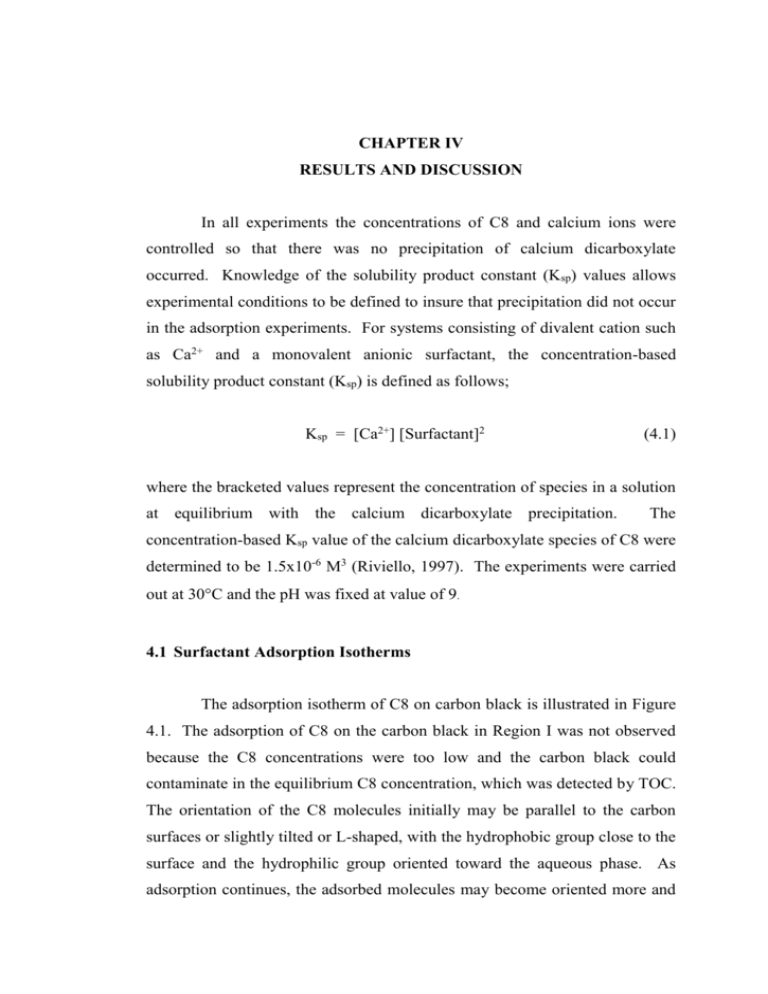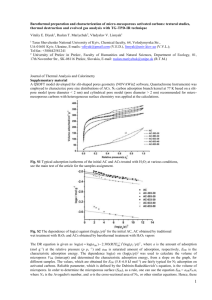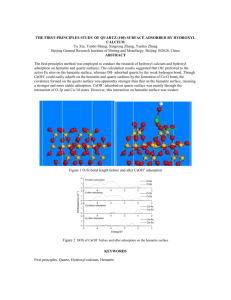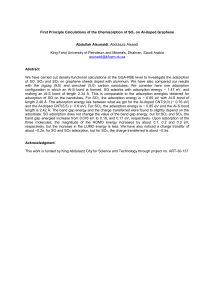Chapter IV Results and Discussion
advertisement

CHAPTER IV RESULTS AND DISCUSSION In all experiments the concentrations of C8 and calcium ions were controlled so that there was no precipitation of calcium dicarboxylate occurred. Knowledge of the solubility product constant (Ksp) values allows experimental conditions to be defined to insure that precipitation did not occur in the adsorption experiments. For systems consisting of divalent cation such as Ca2+ and a monovalent anionic surfactant, the concentration-based solubility product constant (Ksp) is defined as follows; Ksp = [Ca2+] [Surfactant]2 (4.1) where the bracketed values represent the concentration of species in a solution at equilibrium with the calcium dicarboxylate precipitation. The concentration-based Ksp value of the calcium dicarboxylate species of C8 were determined to be 1.5x10-6 M3 (Riviello, 1997). The experiments were carried out at 30C and the pH was fixed at value of 9. 4.1 Surfactant Adsorption Isotherms The adsorption isotherm of C8 on carbon black is illustrated in Figure 4.1. The adsorption of C8 on the carbon black in Region I was not observed because the C8 concentrations were too low and the carbon black could contaminate in the equilibrium C8 concentration, which was detected by TOC. The orientation of the C8 molecules initially may be parallel to the carbon surfaces or slightly tilted or L-shaped, with the hydrophobic group close to the surface and the hydrophilic group oriented toward the aqueous phase. As adsorption continues, the adsorbed molecules may become oriented more and 24 more perpendicular to the surface with hydrophilic heads oriented toward the aqueous solution (Rosen, 1989). The adsorption isotherm of C8 on paper fiber appeared to be S-shape as shown in Figure 4.2 (Rosen, 1989). The adsorption of C8 remained almost constant at low C8 concentrations. As increasing C8 concentration, the C8 adsorption increased rapidly then nearly constant when the paper fiber surfaces were covered with monolayer or bilayer of C8. For each isotherm, the adsorption of C8 at low range of C8 concentration increased with increasing the equilibrium C8 concentrations. However, the adsorption was nearly constant above the CMC, 350000 M as reported by Mukerjee and Mysel (1970). The maximum adsorption of C8 on the carbon black was approximately 7.1 mole/m2 and the maximum adsorption of C8 on paper fiber was approximately 7.8 mole/m2. The theoretical maximum adsorption corresponding to saturation of the entire surface by either monolayer or bilayer can be calculated from the area of single adsorbed surfactant molecule. Adamson (1990) reported an area of 20.5 Å2 for a carboxylate molecule adsorbed in close-packed orientation on surfaces such as carbon black. Using this value, monolayer coverage would require 8.1 mole/m2. Bilayer coverage would result in the doubling of this value. The maximum adsorption of C8 on carbon black and paper fiber from the experiments corresponded to 87.7% and 96% of monolayer coverage, respectively. 25 2 Adsorption density ( mole/m ) 10.00 1.00 0.10 0.01 1,000 10,000 100,000 1,000,000 Equilibrium concentration of C8 (M) Figure 4.1 The adsorption isotherm of C8 on carbon black without calcium addition. 2 Adsorption density (mole/m ) 10.00 1.00 0.10 1,000 10,000 100,000 1,000,000 Equilibrium C8 concentration (M) Figure 4.2 The adsorption isotherm of C8 on paper fiber without calcium addition. 26 Figure 4.3 is a comparison of the C8 adsorption isotherms on both carbon black and paper fiber. The carbon black and paper fiber have the same loading of adsorbate based on dry surface area of 96 m2/g for carbon black and 100 m2/g for paper fiber. The surface of the carbon black is hydrophobic and the surface of the paper fiber is hydrophilic (Rosen, 1989). For the carbon black and paper fiber in water, the PZC were determined to be approximately 2.3 and 3.6, respectively. Indicating that at pH levels above 2.3, the carbon black has a net negative charge and pH above 3.6, the paper fiber has a net negative charge. In all experiments, the pH of 9 was carried out so that the carbon black and paper fiber surfaces had a negatively charged. These data suggested that C8 had the same affinity for the carbon black and the paper fiber. 2 Adsorption density ( mole/m ) 10.00 carbon black 1.00 paper fiber 0.10 0.01 100 1,000 10,000 100,000 1,000,000 Equilibrium concentration of C8 (M) Figure 4.3 The C8 adsorption isotherms on carbon black and paper fiber without calcium addition. 27 4.2 Effect of Calcium Concentration on the Surfactant Adsorption Adsorption of C8 on the carbon black in the presence of varying initial calcium concentrations is shown in Figure 4.4. In the experiments, the C8 concentrations were varied from 1,000 to 700,000 M, 1,000 to 200,000 M, 1,000 to 40,000 and 1,000 to 30,000 M for the initial calcium concentration of 0, 100, 700 and 1000 M, respectively. The results showed that increasing initial calcium concentrations led to increase the adsorption of C8 on the carbon surfaces. As shown in Figure 4.5, increasing the adsorption of C8 caused adsorption of calcium ions on carbon black increased, presumably as the cations associated with exposed anionic surfactant head groups, which led to a decrease in the repulsive forces among the head groups of surfactants. Moreover, decreasing the electrical repulsion between the similar charged adsorbed ions resulted in closer packing. Interesting result was observed in this experiment, the adsorption of C8 increased when the initial calcium concentrations increased at low level of C8 concentrations. The mechanism of anionic surfactant and calcium adsorption was suggested that surfactant molecule was lied flat on the carbon surface, the calcium ions exposed to the head group of the surfactant and induced the other surfactant molecule to adsorb on the carbon surface. On the other hand, the adsorption of C8 did not increase at high C8 concentrations when the initial calcium concentrations increased. Due to the C8 concentration increased, the number of C8 molecules on the carbon surface increased, the adsorbed molecules formed as orientation or surface saturated with the monolayer covered on the carbon surfaces so there was not enough surface for increasing the adsorption of C8. 28 2 Adsorption density ( mole/m ) 10.00 1.00 Ca2+ = 0 uM 0.10 Ca2+ = 100 uM Ca2+ = 700 uM Ca2+ = 1000 uM 0.01 100 1,000 10,000 100,000 1,000,000 Equilibrium concentration of C8 (M) Figure 4.4 The adsorption isotherms of C8 on carbon black with varying initial calcium concentration. Ca2+ = 100 uM Ca2+ = 700 uM 2 Adsorbed Ca (mole/m ) 1.00 Ca2+ = 1000 uM 2+ 0.10 0.01 0.00 0.01 0.10 1.00 10.00 Adsorbed C8 (mole/m2) Figure 4.5 C8 adsorption versus calcium adsorption on carbon black with varying initial calcium concentration. 29 Figure 4.6 shows the adsorption of C8 on the paper fiber in the presence of varying initial calcium concentrations. The C8 concentrations were varied from 500 to 800,000 M, 1,000 to 35,000 M and 1,000 to 10,000 M for initial calcium concentration of 0, 100 and 1,000 M, respectively. The addition of various amounts of calcium had effect on adsorbed C8 density on the paper fiber surfaces. The adsorption of C8 slightly increased with increasing the initial concentration of calcium ions. This type of cooperative adsorption was common with ionic surfactants in the presence of oppositely charged ions and was due to diminished electrostatic repulsion between the head groups of the surfactants caused by binding or coadsorption of counterion. In most instances, adsorption of the calcium ions also increased with increasing surfactant concentration, C8 adsorption increased due to association with exposed head groups of the anionic surfactants. This trend is observed in Figure 4.5 by the data set for adsorption of calcium ions on the carbon black as a function of C8 adsorption. However, the opposite trend is observed for C8/fiber system as shown in Figure 4.7, increasing the adsorption of C8, the adsorption of calcium on paper fiber decreased. This effect was observed by Riviello (1997) and he suggested that there might be due to the expulsion of calcium that was associated with the paper fiber. These results indicated that there was an association between the carboxylate and the paper fiber surface. Consideration of the results illustrated that adsorption of C8 on carbon black was higher than that on the paper fiber occurring at low equilibrium concentration of C8 (1,000-10,000 M). At higher concentrations of C8, the adsorption of C8 on both carbon black and paper fiber were the same loading and nearly constant as increasing initial calcium concentration. The data depicted an apparent window of opportunity for preferential flotation of the carbon black with respect to the C8 concentration. 30 Ca2+ = 0 uM 2 Adsorption density ( mole/m ) 10.0 Ca2+ = 1000 uM Ca2+ = 2000 uM 1.0 0.1 100 1,000 10,000 100,000 1,000,000 Equilibrium C8 concentration (M) Figure 4.6 The adsorption isotherms of C8 on paper fiber with varying initial calcium concentration. 2+ 2 Adsorbed Ca (mole/m ) 0.1 Ca2+ = 1000 uM Ca2+ = 2000 uM 0.01 0.1 1 Adsorbed C8 (mole/m2) Figure 4.7 C8 adsorption versus calcium adsorption on paper fiber with varying initial calcium concentration. 31 4.3 Calcium Adsorption Isotherms Figure 4.8 and Figure 4.9 illustrate the adsorption of calcium on the carbon black and paper fiber in the absence of C8 and show the affinity of calcium ion adsorption to be similar magnitude to that of the C8 adsorption. The calcium ions were attracted by the negatively charged sites on the carbon surfaces resulting from surface oxidation and were attached to the negative sites on the paper fiber resulting from ionization of the carboxylate and hydroxyl. Generally, bare cations are smaller than anions, and they bond tenaciously to hydrating water molecules. The interaction between adsorbed calcium ions was not able to occur since aqueous molecules surrounding adsorbed ions and the lateral interactions were repulsive, not attractive. Consequently, it could be concluded that the adsorption of this type is purely electrostatic and non-associative (Riviello, 1997). The ionic radius of calcium ion was 0.099 nm (Russell, 1992). The close-packed monolayer coverage of adsorbed calcium from calculation was 167.8 mole/m2 (Kornprapakul, 2000). The plateau adsorption of calcium ions on carbon black and paper fiber surfaces found in this work were approximately 0.88 mole/m2 and 1.98 mole/m2 corresponding to 0.52% and 1.18% of close-packed monolayer coverage, respectively. 32 2 Adsorption density ( mole/m ) 1.00 0.10 10 100 1,000 10,000 100,000 Equilibrium calcium concentration (M) Figure 4.8 The adsorption isotherm of calcium on carbon black in the absence of C8. 2 Adsorption density ( mole/m ) 10 1 0.1 0.01 100.00 1,000.00 10,000.00 100,000.00 Equilibrium calcium concentration (M) Figure 4.9 The adsorption isotherm of calcium on paper fiber in the absence of C8. 33 4.4 Effect of Surfactant Concentration on the Calcium Adsorption The effect of C8 concentrations on the adsorption of calcium on carbon black is shown in Figure 4.10. The results of calcium adsorption increased with increasing C8 concentrations, because the synergistic coadsorption is observed. The adsorbed C8 on the carbon black was in the form of the laying down configuration. The hydrophobic tail group of C8 interacted with the carbon surface then the calcium ion was binding to the exposed negative charged group. These situations might increase the adsorption of calcium ion when the concentration of C8 increased. Figure 4.11 depicts the effect of the C8 concentration on the adsorption of calcium on paper fiber. The adsorption of calcium ions slightly decreased with increasing C8 concentration. Because the C8 adsorbed on the fiber with horizontal lay-down configuration, the hydrophobic part of C8 molecule covered on the negatively charged sites of fiber which might consequently be the barriers for calcium ions to be adsorbed on the remaining negatively charged sites as calcium adsorption decreased. The other reason was the expulsion of calcium which was associated with fiber (Riviello, 1997). These results confirmed that there was an association between the carboxylate and the fiber surface. 34 2 Adsorption density ( mole/m ) 10 1 C8 = 0 uM 0.1 C8 = 100 uM C8 = 500 uM C8 = 1000 uM 0.01 10 100 1,000 10,000 100,000 Equilibrium calcium concentration (M) Figure 4.10 Calcium adsorption on carbon black with varying initial C8 concentration. 2 Adsorption density (mole/m ) 10 1 C8 = 0 uM 0.1 C8 = 500 uM C8 = 1000 uM 0.01 100 1,000 10,000 100,000 Equilibrium calcium concentration (M) Figure 4.11 concentration. Calcium adsorption on paper fiber with varying initial C8 35 4.5 Zeta Potential Measurements The zeta potential directly relates to the dispersion of particles. This measurement is an estimation of the electrical charge of a particle at the shear layer of adsorption as determined by its electrophoretic mobility. The point at the zeta potential of zero is called the point of zero charge (PZC). The PZC was determined to be approximately 2.3 for carbon black in water and approximately 3.6 for fiber in water. Figure 4.12 shows the zeta potential of the carbon black as a function of equilibrium C8 concentration with varying initial calcium concentrations. From the result of the zeta potential of the carbon black without calcium addition, the C8 concentration had essentially no effect on the measured zeta potential even though the adsorbed molecules carried a negative charge. The lack of zeta potential might result from counterion binding of the associated sodium ions to the relatively small amount of C8 adsorbed to the surface. However, when calcium ions were added to the system, the zeta potential of the carbon particles decreased dramatically as shown in Figures 4.12 and 4.13, regardless of the C8 concentration. It was probably due to calcium ions neutralized the negatively charged site on carbon surfaces and hydrophilic of C8. For system with C8 presented, the zeta potential of carbon black was observed to be a function only of the calcium ion concentration and was not substantially affected by the C8 concentration. Interestingly, C8 addition actually caused a reduction in the magnitude of the zeta potential of the carbon black when calcium ions were presented. This effect might reflect the synergistic cooperative adsorption of the calcium. Because the zeta potential could directly relates to the aggregation potential of particles, it might be assumed that agglomeration of the carbon was independent of the C8 concentration. 36 (-) Zeta potential (mV) 50 Ca2+ = 0 uM Ca2+ = 100 uM Ca2+ = 700 uM 40 Ca2+ = 1000 uM 30 20 10 0 0 5,000 10,000 15,000 20,000 Equilibrium C8 concentration (M) Figure 4.12 The relation between zeta potential of carbon black and equilibrium C8 concentration at various initial calcium concentration 30 (-) Zeta potential (mV) C8 = 0 uM 25 C8 = 100 uM C8 = 500 uM 20 C8 = 1000 uM 15 10 5 0 0 500 1,000 1,500 2,000 Equilibrium calcium concentration (M) Figure 4.13 The relation between zeta potential of carbon black and equilibrium calcium concentration at various initial C8 concentration. 37 Figure 4.14 shows the zeta potential of the paper fiber as a function of equilibrium C8 concentration with varying initial calcium concentrations. The result indicated that adding C8 concentration in the absence of calcium caused the absolute magnitude of negative zeta potential decreased approximately 10 mV, from 30 to 20 mV, with C8 adsorption on the surface even though the adsorbed molecules carried a negative charge. Because C8 might be adsorbed on the paper fiber surface with the horizontal lay-down configuration which made the hydrophobic part of C8 molecules covered more on the negatively charged sites of paper fiber surfaces. In all cases, increasing calcium concentration further decreased the absolute magnitude of zeta potential as shown in Figure 4.14 and Figure 4.15 because calcium ions neutralized the negatively charged sites on fiber surface and hydrophilic groups of C8. The C8 caused a change of approximately 10 mV in the zeta potential of paper fiber for system with C8 presented while the zeta potential of carbon black was only a 3 mV. These results were likely to be another manifestation of the anomalous association between the carboxylate and the functional groups on the fiber surface as might be predicted from the adsorption data and the observed the calcium exclusion effect (Riviello, 1997). 38 35 Ca2+ = 0 uM (-) Zeta potential (mV) 30 Ca2+ = 500 uM 25 Ca2+ = 1000 uM 20 15 10 5 0 0 200 400 600 800 1,000 1,200 Equilibrium C8 concentration (M) Figure 4.14 The relation between zeta potential of paper fiber and equilibrium C8 concentration at various initial calcium concentration. (-) Zeta potential (mV) 35 C8 = 0 uM 30 C8 = 500 uM 25 C8 = 1000 uM 20 15 10 5 0 0 200 400 600 800 1,000 Equilibrium calcium concentration (M) Figure 4.15 The relation between zeta potential of paper fiber and equilibrium calcium concentration at various initial C8 concentration. 39 In order to relate the adsorption and the zeta potential data to collector chemistry mechanisms, it was suggested that the mechanisms of collector chemistry were adsorptive-based rather than precipitative-based. Experiments conducted below the Ksp of the calcium-dicarboxylate (no precipitation) exhibited the reduction of zeta potential that implied to the aggregation of carbon for the C8/Ca2+ system. The bulk phase precipitation was not necessary for agglomeration (Riviello, 1997). The results of the adsorption and the reduction of zeta potential suggested that the carboxylate molecule complex in a cooperative adsorption mechanism could cause aggregation. Consideration of the results presented in this investigation led to the conclusion that the C8 exhibited synergistic coadsorption of the surfactant and calcium ions. C8 interacted with the calcium to cause carbon black particle aggregation and attachment to the air-water interface of rising bubbles. Figure 4.16 schematically illustrates this proposed scenario. While calcium ions may electrostatically adsorbed onto oxidized sites on the carbon black causing decreased surface charge. Association of the divalent cation with the head group of the carboxylate might create localized regions of hydrophobic calcium-carboxylate complex, which might aid in the attachment of the carbon black particle to the gas/water interface of a rising bubble. Ca2+ Ca2+ Ca2+ Ca2+ Carbon black Figure 4.16 Schematic of proposed collector chemistry mechanism depicting the association of the calcium ions with the adsorbed C8.








